service BUICK REGAL 1998 Owners Manual
[x] Cancel search | Manufacturer: BUICK, Model Year: 1998, Model line: REGAL, Model: BUICK REGAL 1998Pages: 388, PDF Size: 20.19 MB
Page 3 of 388
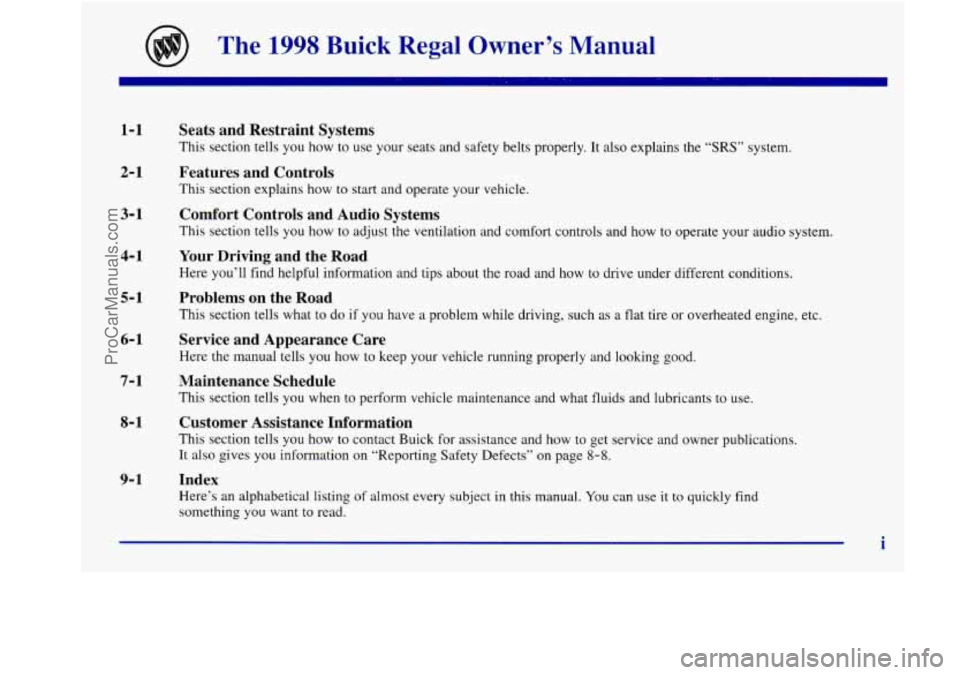
The 1998 Buick Regal Owner’s Manual
1-1
2-1
3-1
4- 1
5-1
6- 1
7-1
8- 1
9- 1
Seats and Restraint Systems
This section tells you how to use your seats and safety belts\
properly. It also explains the “SRS” system.
Features and Controls
This section explains how to start and operate your vehicle.
Comfort Controls and Audio Systems
This section tells you how to adjust the ventilation and comfo\
rt controls and how to operate your audio system.
Your Driving and the Road
Here you’ll find helpful information and tips about the road\
and how to drive under different conditions.
Problems on the Road
This section tells what to do if you have a problem while driving, such as a flat tire or overheated engine, etc.
Service and Appearance Care
Here the manual tells you how to keep your vehicle running properly and looking good.
Maintenance Schedule
This section tells you when to perform vehicle maintenance and what fluids and lu\
bricants to use.
Customer Assistance Information
This section tells you how to contact Buick for assistance and how to get service and owner publications.
It also gives you information on “Reporting Safety Defects” on page 8-8.
Index
Here’s an alphabetical listing of almost every subject in this manual. You can use it to quickly find
something you want to read.
i
ProCarManuals.com
Page 4 of 388
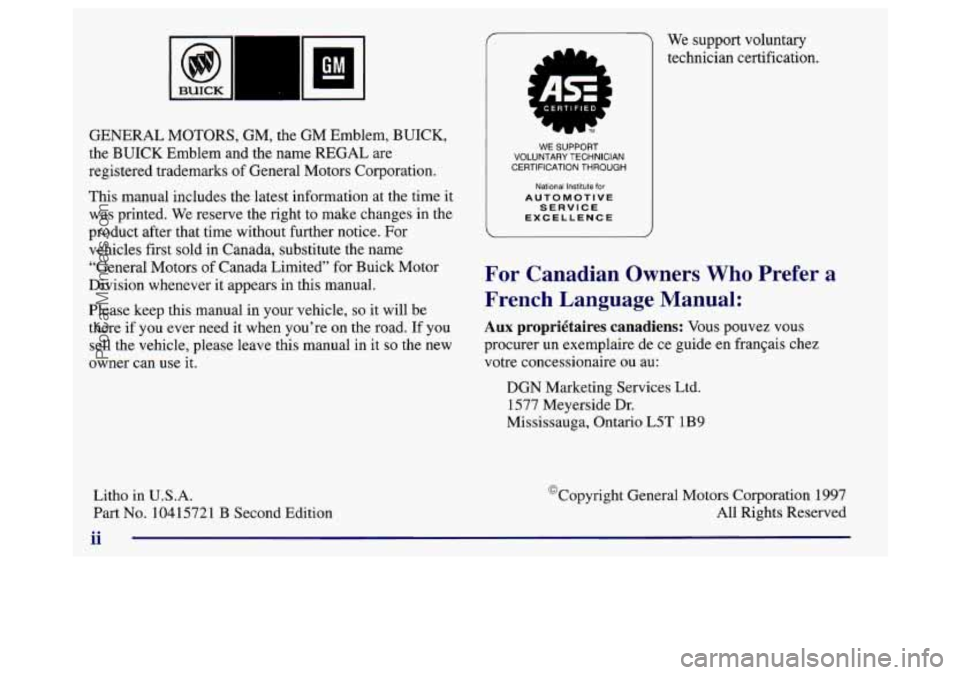
I BUICK L
GENERAL MOTORS, GM, the GM Emblem, BUICK,
the BUICK Emblem and the name REGAL are
registered trademarks of General Motors Corporation.
This manual includes the latest information at the time it
was printed. We reserve the right to make changes in the
product after that time without further notice. For
vehicles first sold in Canada, substitute the name
“General Motors
of Canada Limited” for Buick Motor
Division whenever
it appears in this manual.
Please keep this manual in your vehicle, so it will be
there if
you ever need it when you’re on the road. If you
sell the vehicle, please leave this manual in it
so the new
owner can use it.
Litho in U.S.A.
Part No. 10415721
B Second Edition
WE SUPPORT VOLUNTARY TECHNICIAN
CERTIFICATION THROUGH
AUTOMOTIVE National Institute for
SERVICE EXCELLENCE
We support voluntary
technician certification.
For Canadian Owners Who Prefer a
French Language Manual:
Aux propriktaires canadiens: Vous pouvez vous
procurer
un exemplaire de ce guide en franqais chez
votre concessionaire
ou au:
DGN Marketing Services Ltd.
1577 Meyerside
Dr.
Mississauga, Ontario L5T 1B9
@Copyright General Motors Corporation
1997
All Rights Reserved
ii
ProCarManuals.com
Page 32 of 388
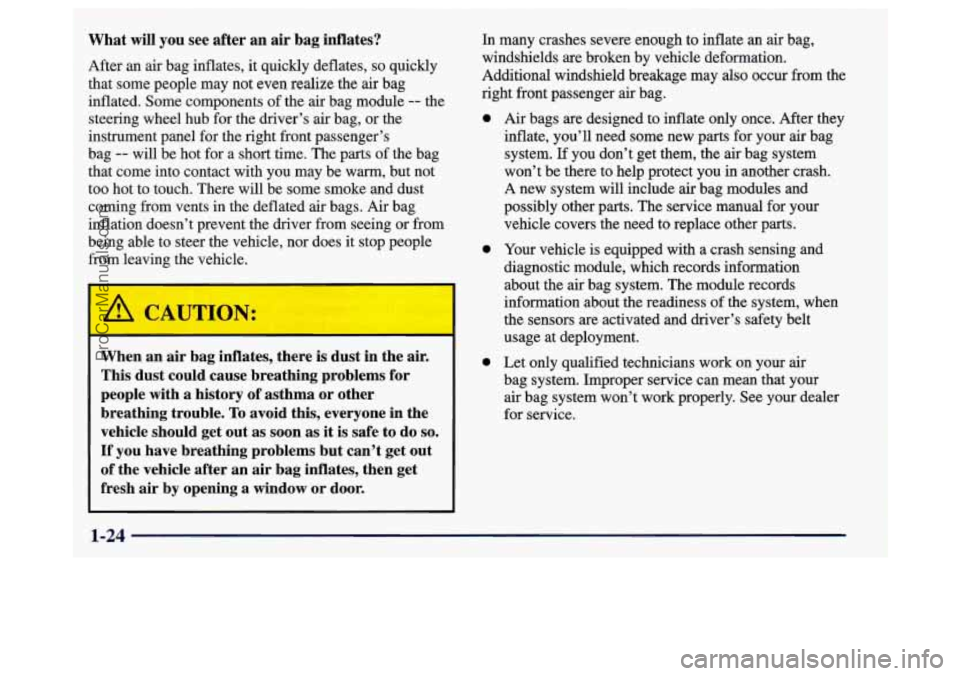
What will you see after an air bag inflates?
After an air bag inflates, it quickly deflates, so quickly
that some people may not even realize the air bag
inflated. Some components of the air bag module
-- the
steering wheel hub for the driver’s air bag, or the
instrument panel for the right front passenger’s
bag
-- will be hot for a short time. The parts of the bag
that come into contact with you may be warm, but not
too hot to touch. There will be some smoke and dust
coming from vents in the deflated air bags. Air bag
inflation doesn’t prevent the driver from seeing or from
being able to steer the vehicle, nor does it stop people
from leaving the vehicle.
/! CAUTION:
When an air bag inflates, there is dust in the air.
This dust could cause breathing problems for
people with a history of asthma or other
breathing trouble. To avoid this, everyone in the
vehicle should get out as soon as it is safe to do
so.
If’ you have breathing problems but can’t get out
of the vehicle after an air bag inflates, then get
fresh air by opening a window or door.
In many crashes severe enough to inflate an air bag,
windshields
are broken by vehicle deformation.
Additional windshield breakage may
also occur from the
right front passenger air bag.
0
0
0
Air bags are designed to inflate only once. After they
inflate, you’ll need some new parts for your air bag
system.
If you don’t get them, the air bag system
won’t be there to help protect you in another crash.
A new system will include air bag modules and
possibly other parts. The service manual for your
vehicle covers the need to replace other parts.
Your vehicle is equipped with a crash sensing and
diagnostic module, which records information
about the air bag system. The module records
information about the readiness of the system, when
the sensors
are activated and driver’s safety belt
usage at deployment.
Let only qualified technicians work on your air
bag system. Improper service can mean that your
air bag system won’t work properly. See your dealer
for service.
1-24
ProCarManuals.com
Page 33 of 388
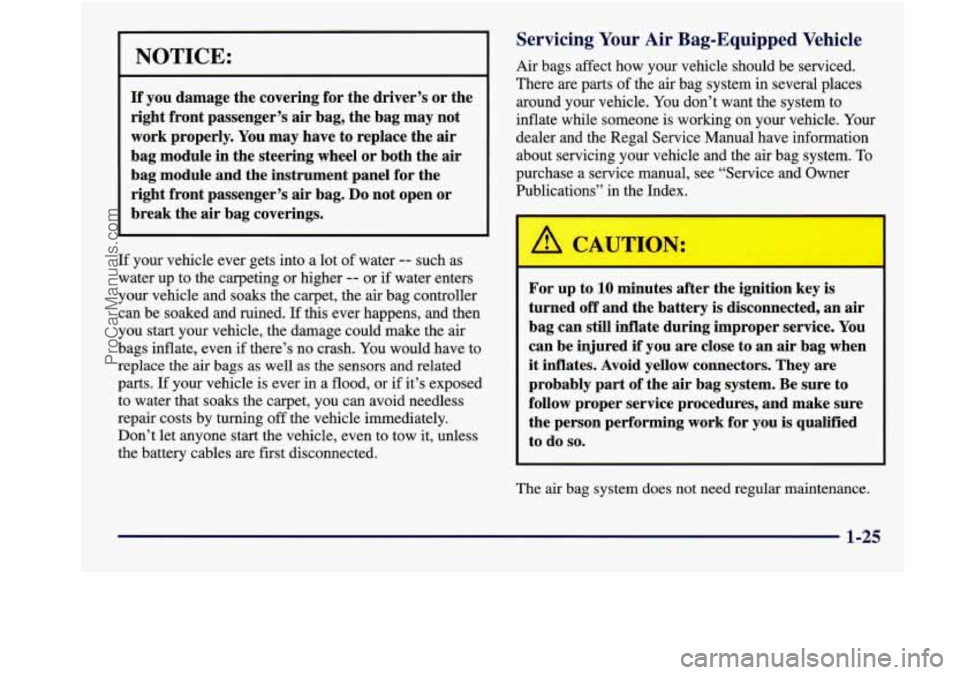
NOTICE:
If you damage the covering for the driver’s or the
right front passenger’s
air bag, the bag may not
work properly. You may have to replace the
air
bag module in the steering wheel or both the air
bag module and the instrument panel for the
right front passenger’s
air bag. Do not open or
break the air bag coverings.
If your vehicle ever gets into a lot of water -- such as
water up to the carpeting or higher
-- or if water enters
your vehicle and soaks the carpet, the air bag controller
can be soaked and ruined.
If this ever happens, and then
you start your vehicle, the damage could make the air
bags inflate, even
if there’s no crash. You would have to
replace the air
bags as well as the sensors and related
parts.
If your vehicle is ever in a flood, or if it’s exposed
to water that
soaks the carpet, you can avoid needless
repair costs by turning off the vehicle immediately.
Don’t let anyone start the vehicle, even to tow it, unless
the battery cables
are first disconnected.
Servicing Your Air Bag-Equipped Vehicle
Air bags affect how your vehicle should be serviced.
There are parts
of the air bag system in several places
around your vehicle.
You don’t want the system to
inflate while someone is working on your vehicle. Your
dealer and the Regal Service Manual have information
about servicing your vehicle and the air bag system. To
purchase a service manual, see “Service and Owner
Publications” in the Index.
For up to 10 minutes after the ignition key is
turned off and the battery is disconnected, an air
bag can still inflate during improper service. You
can be injured
if you are close to an air bag when
it inflates. Avoid yellow connectors. They are
probably part of the air bag system. Be sure
to
follow proper service procedures, and make sure
the person performing work for you
is qualified
to do
so.
The air bag system does not need regular maintenance.
1-25
ProCarManuals.com
Page 53 of 388
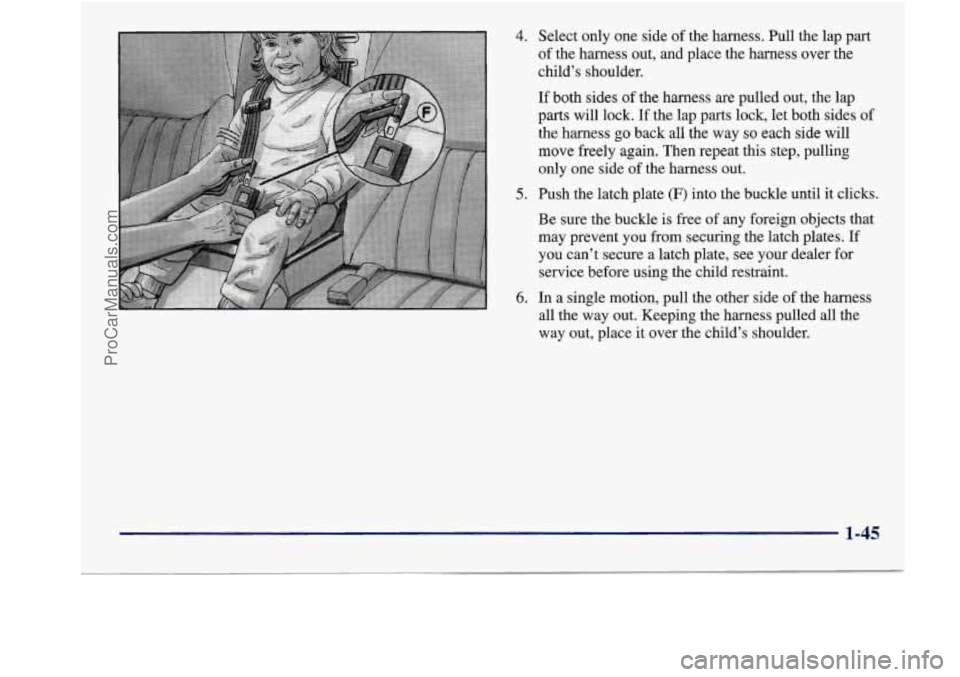
4. Select only one side of the harness. Pull the lap part
of the harness out, and place the harness over the
child’s shoulder.
If both sides of the harness are pulled out, the lap
parts will lock.
If the lap parts lock, let both sides of
the harness go back all the way so each side will
move freely again. Then repeat this step, pulling
only one side of the harness out.
5. Push the latch plate (F) into the buckle until it clicks.
Be sure the buckle is free of any foreign objects that
may prevent you from securing the latch plates.
If
you can’t secure a latch plate, see your dealer for
service before using the child restraint.
6. In a single motion, pull the other side of the harness
all the way out. Keeping the harness pulled all the
way out, place it over the child’s shoulder.
1-45
ProCarManuals.com
Page 56 of 388

If the harness still doesn’t lock, don’t use the child
restraint. See your dealer to have the built-in child
restraint serviced.
9. On both sides of the harness, pull up on the lap part a
little to be sure it’s locked.
If the harness isn’t locked, or if it becomes too tight,
unfasten the harness clip.
Then unlatch the harness
by pushing the button on
the buckle, and let both
sides of the harness go all the way back
so they will
move freely again. Then, repeat Steps
4 through 8.
10. Adjust the position of the harness on the child’s
shoulders by moving the clip
up or down along the
harness. On each side
of the harness, the shoulder
part should be centered on the child’s shoulder. The
harness
should be away from the child’s face and
neck, but not falling off the child’s shoulders.
1-48
ProCarManuals.com
Page 84 of 388
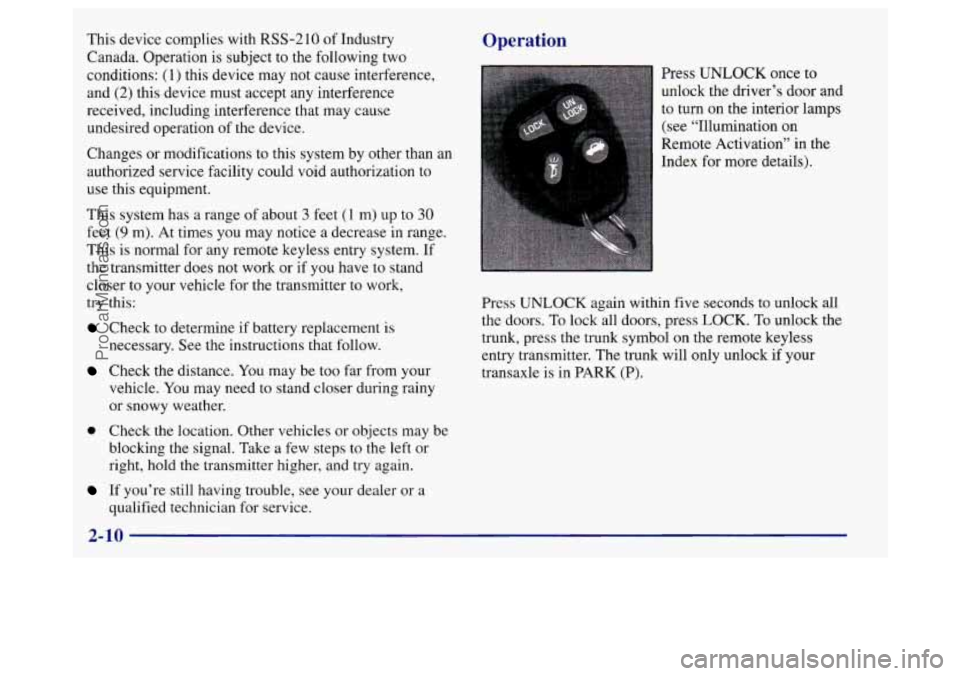
This device complies with RSS-210 of Industry
Canada. Operation is subject to the following two
conditions: (1) this device may not cause interference,
and
(2) this device must accept any interference
received, including interference that may cause
undesired operation of the device.
Changes or modifications to this system by other than an
authorized service facility could void authorization
to
use this equipment.
This system has a range of about
3 feet (1 m) up to 30
feet (9 m). At times you may notice a decrease in range.
This
is normal for any remote keyless entry system. If
the transmitter does not work or if you have to stand
closer to your vehicle for the transmitter to work,
try this:
Check to determine if battery replacement is
necessary. See the instructions that follow.
Check the distance. You may be too far from your
vehicle. You may need to stand closer during rainy
or snowy weather.
0 Check the location. Other vehicles or objects may be
blocking the signal. Take
a few steps to the left or
right, hold the transmitter higher, and try again.
If you’re still having trouble, see your dealer or a
qualified technician for service.
Operation
Press UNLOCK once to
unlock the driver’s door and
to turn on the interior lamps
(see “Illumination on
Remote Activation” in the
Index for more details).
Press
UNLOCK again within five seconds to unlock all
the doors. To lock all doors, press
LOCK. To unlock the
trunk, press the trunk symbol on the remote keyless
entry transmitter. The trunk will only unlock
if your
transaxle is in PARK
(P).
2-10
ProCarManuals.com
Page 90 of 388
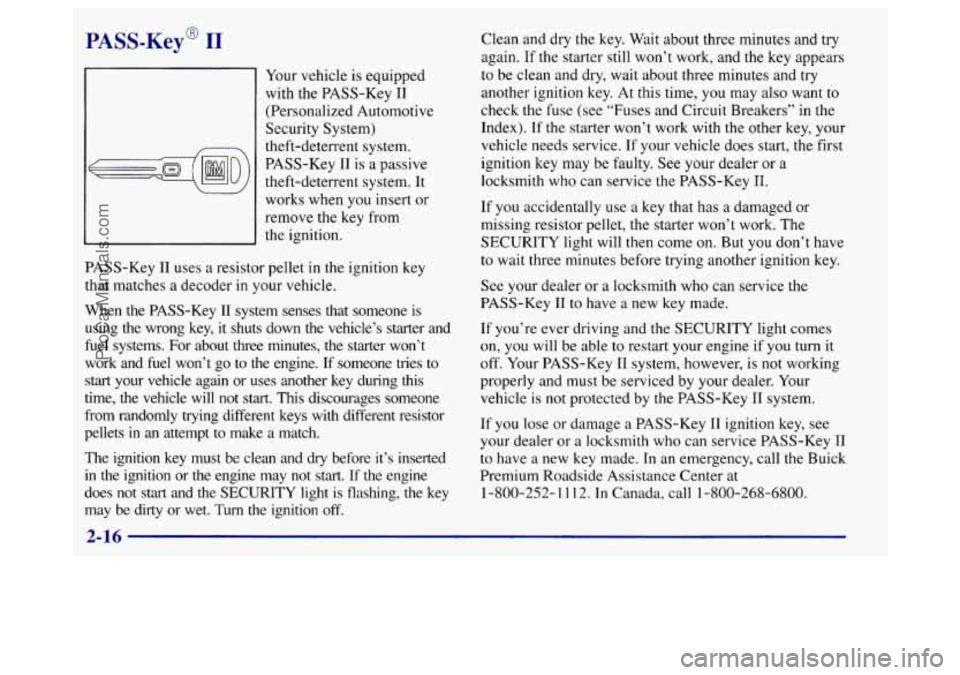
PASS-Key@ I1
Your vehicle is equipped
with the PASS-Key
I1
(Personalized Automotive
Security System)
theft-deterrent system.
PASS-Key I1 is a passive
theft-deterrent system. It
works when you insert or
remove the
key from
the ignition.
PASS-Key
I1 uses a resistor pellet in the ignition key
that matches a decoder
in your vehicle.
When the PASS-Key I1 system senses that someone
is
using the wrong key, it shuts down the vehicle’s starter and
fuel systems. For about three minutes, the starter won’t
work and fuel won’t
go to the engine. If someone tries to
start your vehicle again or uses another key during this
time, the vehicle will not start. This discourages someone
from randomly trying different keys with different resistor
pellets in
an attempt to make a match.
The ignition key must be clean and dry before it’s inserted
in the ignition or the engine may not start. If the engine
does not start and the SECURITY light is flashing, the key
may be dirty or wet. Turn the ignition off. Clean and
dry
the key. Wait about three minutes and try
again.
If the starter still won’t work, and the key appears
to be clean and dry, wait about three minutes and try
another ignition key. At this time, you may also want to
check the fuse (see “Fuses and Circuit Breakers” in the
Index). If
the starter won’t work with the other key, your
vehicle needs service. If your vehicle does start, the first
ignition key may be faulty. See your dealer or a
locksmith who can service the PASS-Key
11.
If you accidentally use a key that has a damaged or
missing resistor pellet, the starter won’t work. The
SECURITY light will then come
on. But you don’t have
to wait three minutes before trying another ignition key.
See your dealer or a locksmith who can service the
PASS-Key
I1 to have a new key made.
If you’re ever driving and the SECURITY light comes
on, you will be able to restart your engine if
you turn it
off. Your PASS-Key I1 system, however, is not working
properly and must be serviced by your dealer. Your
vehicle is not protected by the PASS-Key I1 system.
If you lose or damage a PASS-Key
I1 ignition key, see
your dealer or
a locksmith who can service PASS-Key I1
to have a new key made. In an emergency, call the Buick
Premium Roadside Assistance Center at
1-800-252-
1 112. In Canada, call 1-800-268-6800.
2-16
ProCarManuals.com
Page 92 of 388
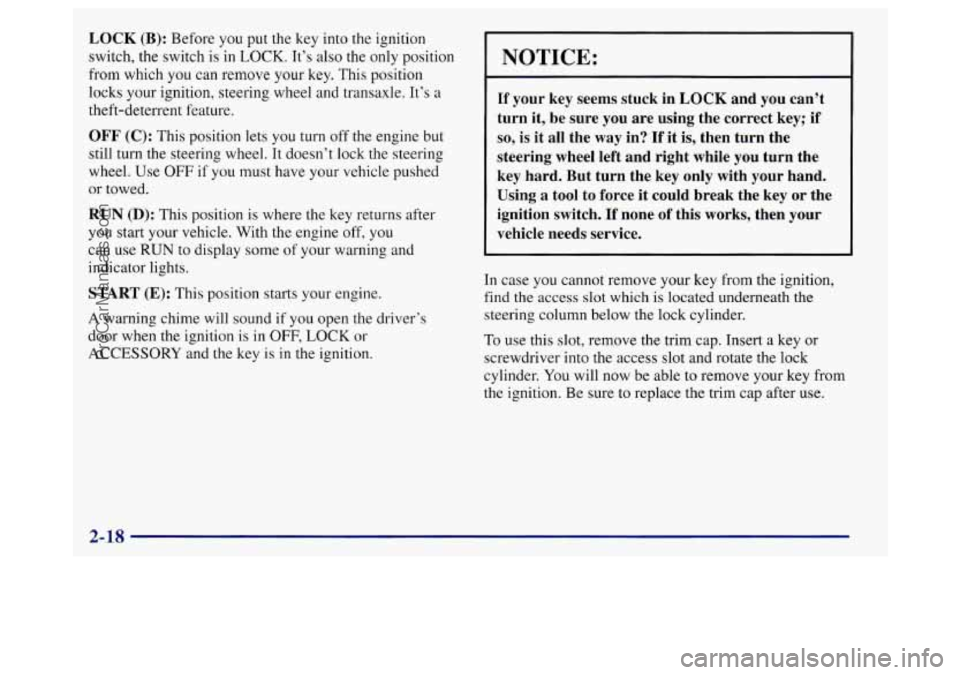
LOCK (B): Before you put the key into the ignition
switch, the switch is in
LOCK. It’s also the only position
from which
you can remove your key. This position
locks your ignition, steering wheel and transaxle. It’s a
theft-deterrent feature.
OF” (C): This position lets you turn off the engine but
still turn the steering wheel. It doesn’t lock the steering
wheel. Use
OFF if you must have your vehicle pushed
or towed.
RUN (D): This position is where the key returns after
you start your vehicle. With the engine off, you
can use
RUN to display some of your warning and
indicator lights.
START (E): This position starts your engine.
A warning chime will sound if you open the driver’s
door when the ignition is in
OFF, LOCK or
ACCESSORY and the key is in the ignition.
‘ NOTICE:
~
If your key seems stuck in LOCK and you can’t
turn
it, be sure you are using the correct key; if
so, is it all the way in? If it is, then turn the
steering wheel left and right while you turn the
key hard. But turn the key only with your hand.
Using
a tool to force it could break the key or the
ignition switch. If none of this works, then your
vehicle needs service.
In case you cannot remove your key from the ignition,
find the access slot which is located underneath the
steering column below the lock cylinder.
To use this slot, remove the trim cap. Insert a key or
screwdriver into the access slot and rotate the lock
cylinder. You will now be able to remove your key from
the ignition. Be sure to replace the trim cap after use.
2-18
ProCarManuals.com
Page 98 of 388
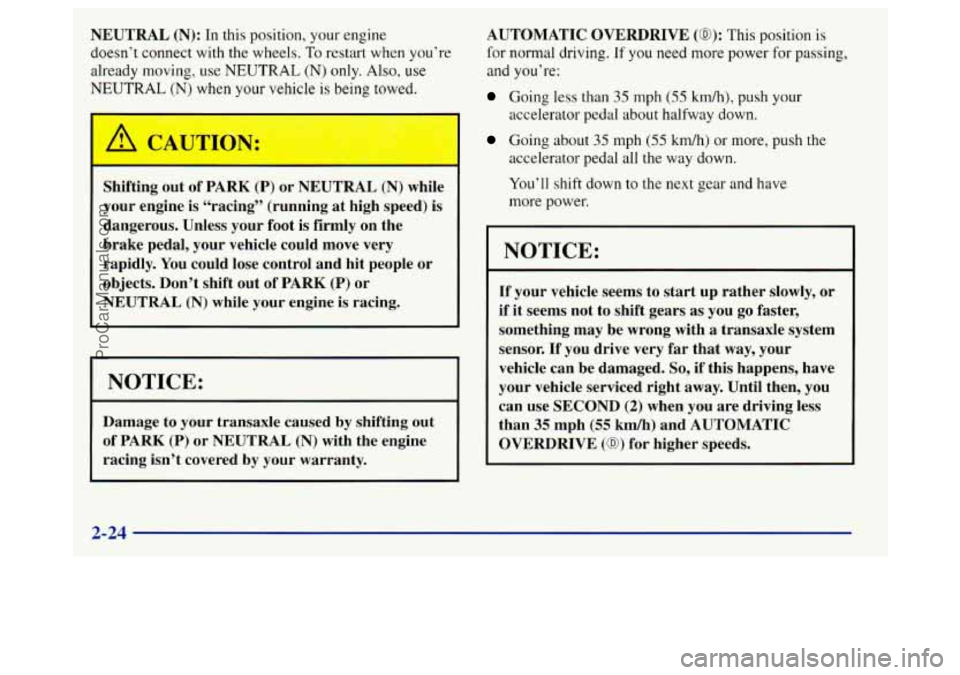
NEUTRAL (N): In this position, your engine
doesn’t connect with the wheels.
To restart when you’re
already moving, use
NEUTRAL (N) only. Also, use
NEUTRAL (N) when your vehicle is being towed.
Shifting out of PARK
(P) or NEUTRAL (N) while
your engine is “racing” (running at high speed) is
dangerous. Unless your foot is firmly on the
brake pedal, your vehicle could move very
rapidly. You could lose control and hit people or
objects. Don’t shift out of PARK
(P) or
NEUTRAL (N) while your engine is racing.
-- 1
NOTICE:
Damage to your transaxle caused by shifting out
of PARK (P) or NEUTRAL (N) with the engine
racing isn’t covered by your warranty. AUTOMATIC
OVERDRIVE (0): This position is
for normal driving.
If you need more power for passing,
and
you’re;
Going less than 35 mph (55 kdh), push your
Going about 35 mph (55 kdh) or more, push the
accelerator pedal about halfway down.
accelerator pedal all the way down.
You’ll shift down to the next gear and have
more power.
NOTICE:
If your vehicle seems to start up rather slowly, or
if it seems not to shift gears as you go faster,
something
may be wrong with a transaxle system
sensor.
If you drive very far that way, your
vehicle can be damaged.
So, if this happens, have
your vehicle serviced right away. Until then, you
can use SECOND
(2) when you are driving less
than
35 mph (55 km/h) and AUTOMATIC
OVERDRIVE
(@) for higher speeds.
2-24
ProCarManuals.com